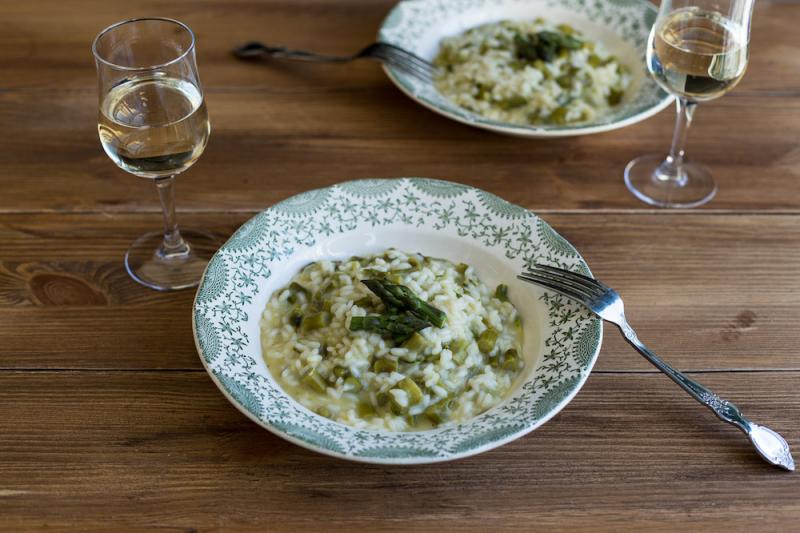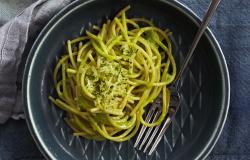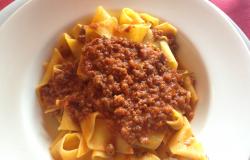Risotto agli Asparagi (Asparagus Risotto)

If it's not pasta-based, then an Italian's choice of starter at lunch or dinner time is most likely a risotto made with the seasonal vegetable du jour. In early to mid-spring, there's a good chance that that vegetable is asparagus or, as they are known in Italian, asparagi.
Highly-prized since Roman times, sweet asparagus are one of the most beloved vegetables along the Italian peninsula. Notable cultivars in the country include two white varieties from the Veneto, including l'asparago bianco di Bassano and Cimaldomo and the deep purple-tinged spears of the Ligurian violetto di Albenga. And, of course, there are the more common green varieties that haven't had their turions (the edible part of an asparagus shoot) buried in soil to prevent photosynthesis, such as l'asparago di Santena and l'asparago di Vinchio, from my adoped region of Piedmont.
After a long, frosty winter consisting of brassicas and root vegetables, not even the premium price tag these spearheaded shoots command deters local food shoppers from cooking with them. As a result, you'll often find asparagus used as the star ingredient in omelettes, soups and savoury tarts at this time of year. Steaming or boiling and dressing them afterwards in olive oil and lemon juice is also a simple but highly effective way of bringing out their flavour. A risotto, that distinctly Italian way of cooking rice, however, would have to be my favourite method for cooking and eating this sublime vegetable.
Provided you have the right rice - look out for Arborio, Baldo, Carnaroli or Vialone Nano varieties - and that your well-versed in its basic cooking stages, making a risotto is quite straightforward. In fact, once you've made the asparagus-based one below, you'll be able to adapt it to whatever vegetable you have on hand. Peas, zucchinis or even the thin, straggly spears of cultivated asparagus' wild counterparts are just a few seasonal vegetables that could work at this time of year too.
Anyway, to start off, there's the soffritto stage. It requires the rendering (but not browning!) of some finely chopped onion in butter. This is followed by the tostatura, or 'toasting', of the rice. You'll need a wooden spoon, preferably a girariso with a hole in it, on hand, for what food and art historian Gillian Riley calls 'some vigorous bashing', of the raw grains of rice against the sides of the pot. After your rice starts making a hissing noise, that's your cue to raise the heat and add a glass of dry white wine, which should be left to simmer until evaporated. Once the alcohol has reduced, you'll begin adding ladlefuls of boiling hot broth or water and stirring constantly, not just to prevent sticking but also to release the starch surrounding each grain of rice into the cooking liquid. Finally, there's the mantecatura or whipping of the butter and grated cheese into the tender but al dente rice that Italians prefer when making this dish.
Two final notes. When prepping and cooking asparagus for a risotto, I like to cut them into pieces about 1.5 cm long, keeping their spear-like tips whole and steam these briefly before adding them to the bubbling rice. I often reserve a few of their delicate spear-headed tips for garnishing at the end too. As for the quantities of rice indicated, 320 -350 g is ideal if this dish is just one part of a multi-course meal. If you're planning on making your risotto a piatto unico or one-dish-meal though, you may want to opt for the more generous quantity of 380 g.
Ingredients (serves 4 as a starter)
Wash, dry and cut the woody ends off the asparagus. Discard ends and cut into pieces 1.5 cm long, reserving their tips which should be left whole. Steam asparagus for 6-8 minutes and transfer to an ice bath to keep them green.
Meanwhile, melt 40 g of the butter over low to medium heat in a wide copper or alluminium pan. Add the minced onion and saute until softened and translucent. Add the rice, allowing it to toast for a couple of minutes, ensuring that you stir the rice often. When it starts turning opaque in colour and makes a hissing noise, increase the heat and pour in the wine. Allow it to evaporate and then stir in the steamed asparagus, reserving a few of the spear-headed tips for the concluding garnish.
Reduce the heat and cook the risotto by adding a ladleful of boiling hot broth at a time, ensuring that the rice has absorbed most of the liquid before adding more. Stir occasionally, using a girariso or a wooden spoon with a hole. Continue this way until the rice feels al dente but tender, around 15 – 17 minutes.
Taste for salt and remove risotto from heat. Cover and leave to rest for 2 minutes. Remove lid, stir in the remaining butter and grated parmesan or grana padano and whip energetically until the fat and cheese has rendered and the rice is creamy. Serve immediately, topped with the steamed tips. Buon appetito!






